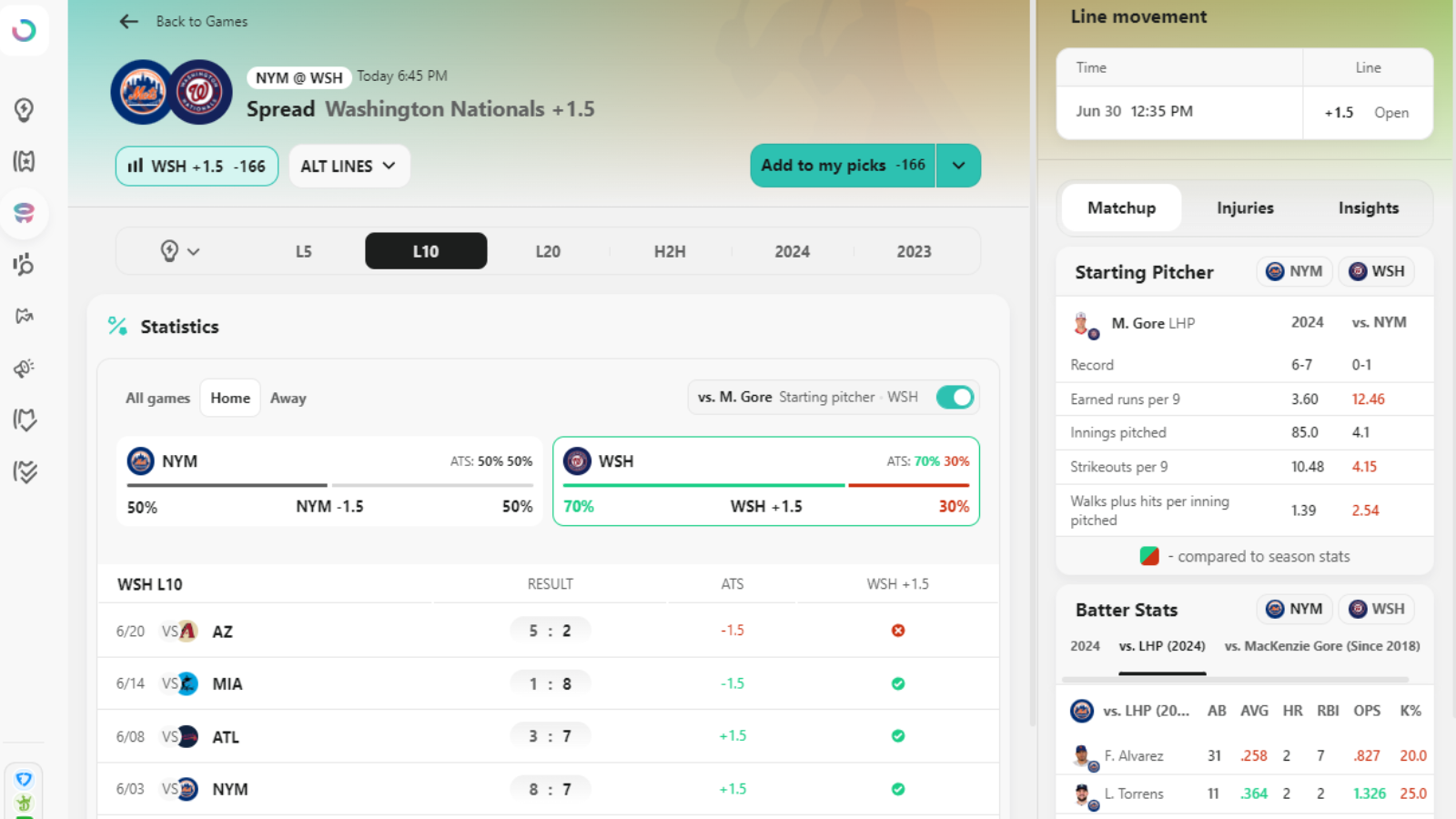4 Winning Tips for MLB Run Line Betting.
Run line betting is baseball’s version of the point spread where teams have to cover 1.5 runs. Betting on it adds a tricky element, though, as you have to consider whether a team can beat that extra margin in game where scoring simply doesn’t happen as fluidly as in basketball or football.
Is it worth the extra run worth the price of admission? We’re taking a closer look at the strategy of betting the runline and examining when it actually makes sense.
- Dogs Tend To Do Well Against The Runline
- Knock Down The Price Of Big Favorites With Moneylines
- Examine Correlating The Total To Runlines
- Avoid Alt Runlines

One-Run Win Percentages & Run Line Betting Correlation
The first thing you’ll want to keep in mind with run line betting is know what percentage of games are decided by a run. The short answer is about 30%. A comprehensive study of about 50,000 games found that 28.6% of games were decided by exactly one run. What’s interesting to note is that the favorite won by exactly one run at 56.9% of the time while the underdog won at a clip of 43.1%.
The reason you need to keep these figures in mind is because you’re either taking the run (+1.5) or laying it (-1.5), so one becomes a very key number.
The next piece to this puzzle is to consider which team is at home. When you’re laying an extra run with a team that’s at home, remember that if they’re leading after the top of the ninth inning, they’re not going have an at-bat at the end of the game. That makes it a little more challenging for home teams to cover the 1.5 runs. Conversely, road teams will almost always have the opportunity to bat the full nine innings (assuming that the game isn’t shortened).
Take a look below at the table to see the results from a sample size of 10’s of thousands of games that were taken. Of course, the game changes over time, but these are rough numbers to keep in mind when runline betting on the favorites at home versus away.
| Result | Home Favorite | Road Favorite |
| Win by two or more | 39% | 44% |
| Win by exactly one | 18% | 12% |
| Lose by exactly one | 11% | 16% |
| Lose by two or more | 32% | 28% |
Not surprisingly, we can see that road favorites actually cover the -1.5 more than home favorites. That’s likely in part to the aforementioned extra at-bat. At the same time, remember that road favorites will also have to deal with the bottom of the ninth if they’re ahead and we can see that those home dogs close the gap to one run at times. Road favorites lose by exactly one run more than home favorites do.

Dogs Tend To Do Well Against The Run Line
One thing that we can extrapolate from the numbers above is that underdogs deliver a majority of the time on the runline. Looking at the home favorites above, we can see that they win by one run 18% of the time, lose by one run 11% of the time and lose by two or more 32% of the time. Adding those three numbers, we see that they actually fail on the runline 61% of the time. Tracking the same math with road favorites and we see home dogs actually come through at 56% of the time.
Regarding big favorites in MLB — Are you better off doing a 2 unit bet on the moneyline or a 1 unit bet on the runline?
Since the beginning of last season, betting $200 on ML favorites of -200 returned $930.
Betting $100 on the RL in those spots returned -$644.
Stick to ML.
— Joe Osborne (@JTFOz) May 15, 2018
In short, that taking the +1.5 can make sense when runline betting in baseball. So why don’t bettors always blindly hammer the underdog runline? Unfortunately, the oddsmakers are aware of these numbers and that means that you’ll have to pay an extra price for underdogs. It’s good to know and play the percentages, but you have to pick your spots.
Knock Down The Price Of Big Favorites With Moneylines
Big favorites are probably least reliable in baseball than they are in any of the major North American sports. Taking a look at something like college football or the NBA, big moneyline favorites tend to do pretty well. In the NBA, home-court advantage is quite valuable and those big favorites cash in more often than not. In college football, there are only about a dozen games, so teams are really focused to make sure they don’t blow opportunities more than once. In baseball, though, the season is 162 games long. A loss doesn’t sting so much because there’s always tomorrow.
A study from 2015 to 2020 showed that underdogs in baseball won more than in any other major sport. Dogs barked at a rate of 41.6% in baseball compared to 34.2% in the NFL, 32.1% in the NBA and 21.9% in college football.
That being the case, you have to be quite careful laying the juice on some of these big favorites in baseball. Sure, seeing the top team in the league with their ace on the mound looks like an attractive bet but even in the best of times, it’s still a question mark if they’ll deliver. Nonetheless, the sportsbooks will charge you a pretty penny to place that bet. Runline betting can protect you in the spots that they don’t win.
In the 2022 season, Justin Verlander won the Cy Young Award by going 18-4 in his 32 starts. However, if you were betting to win $100 on each of his starts, you’d only be ahead $276. That’s because the losses would be quite costly since he was favored heavily every time. That’s why you want to consider knocking it down with the run line. Yes, you won’t win as often but you can save on the losses and mitigate some of that risk.
Many sharp sports bettors simply won’t lay a moneyline favorite after a certain number – for some as low as -150 – so consider runline bettingas a strategy to still invest in favorites but not pay so much.
Correlating The Total To Run Line Betting
There’s an easy way to determine a value of a run in a baseball game and that’s essential in this evaluation. We’re either laying an extra run or taking one, so having a calculation to quantify that run is central.
The way to do the math here is to cross-reference the number with the total. If you’re looking at a game with a total of six, then you can estimate that 1.5 runs will account for 25% of the over-under set by the oddsmakers. In this situation, the run and a half might cost you more. However, if you’re laying 1.5 and the total for the game is 12, then the 1.5 runs only accounts for 12.5% of the runs. That means it’ll cost you less. The theory is simply that if runs are at a premium, then cover 1.5 (winning by two) is going to be harder. If the oddsmakers expect more runs in the game overall, then it’ll be easier to cover 1.5.
Avoid Alt Run Lines
Sportsbooks have expanded their baseball offering quite a bit in recent years. There was a time where you’d only get a -1.5 and a +1.5 on each game, and then occasionally an alternate run line. Now you can bet anything you want, including -2.5, -3.5, +4.5, +5.5 and so on.
The challenge with betting any of these lines is that the spread on the juice gets very high. You’re paying a big price either to get extra runs or you’re not getting paid enough if you’re giving up runs. Generally, it’s not recommended. There’s also scant handicapping information with things like trends, stats, etc. to help you examine whether laying -2.5, -3.5 or whatever alt runline you’re betting makes sense or not.
Frequently Asked Questions
How does the run line work in baseball?
Betting on the run line in baseball is slightly different than simply picking a team to win the game. The run line means that you’re betting on a team to either win by 1.5 runs, which means they have to win by two or more. Or you’re betting on the underdog with 1.5 runs, which means they can lose by exactly one run or win the game, and you’d win your bet. The run line is written as -1.5 when a team has to win by two or +1.5 when a team can lose by exactly one and still win for you.
Is the run line a point spread?
The run line is essentially a point spread in baseball. When you see -1.5, that is a spread that the favorite needs to cover for you to win your bet. When you see +1.5, that’s a spread as well. In this case, your side can lose by one or win, and you’d win your bet.
How are run lines priced out?
Sportsbooks have their calculation for pricing out a run line but in short, a team that is favored will cost much less on a run line than a moneyline. That’s because they’re less likely to win by two runs than by one run, so the oddsmakers will pay you more accordingly. As for the underdog, they’ll pay less on the run line because they’re less likely to win the game rather than to lose by one or win the game.
How often does a home favorite win on the run line?
One extensive study of 10’s of thousands of baseball games showed that home favorites win by two or more 39% of the time.
How often does a road favorite win on the run line?
An in-depth examination of 10’s of thousands of baseball games showed that road favorites win by two runs about 44% of the time.
